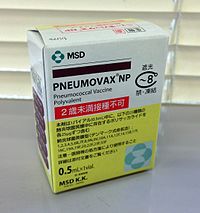
Photo from wikipedia
The 13-valent conjugate vaccine (PCV13) was recommended for childhood immunization programs in 2010 in Canada and has decreased the incidence of invasive pneumococcal disease (IPD) in children and changed the… Click to show full abstract
The 13-valent conjugate vaccine (PCV13) was recommended for childhood immunization programs in 2010 in Canada and has decreased the incidence of invasive pneumococcal disease (IPD) in children and changed the epidemiology of IPD in adults. This study investigated the epidemiology of IPD in adults 65 years of age and older in Canada. A total of 7282 invasive S. pneumoniae isolated from adults ≥65 years old were serotyped from 2010 to 2016 and antimicrobial susceptibility was performed on 2527 isolates. Serotyping was performed by Quellung reaction using commercial antisera and antimicrobial susceptibilities were determined by broth microdilution. PCV7 serotypes decreased non-significantly from 2010 to 2016 from 9.1% (n = 96) to 6.7% (n = 72) while the additional six PCV13 serotypes declined significantly from 39.5% (n = 418) to 18.6% (n = 201) (p < 0.05). The 23-valent pneumococcal polysaccharide vaccine (PPV23) and non-vaccine (NVT) serotypes increased from 26.3% (n = 278) to 36.2% (n = 393) (p < 0.05), and from 25.1% (n = 266) to 38.4% (n = 416) (p < 0.05), respectively. There were no significant changes in antimicrobial resistance rates from 2011 to 2016: 24.1% of the IPD from adults ≥65 years were resistant to clarithromycin (n = 609), 10.0% to doxycycline (n = 254), 11.8% to penicillin (n = 299), 5.2% to cefuroxime (n = 131), 6.6% to clindamycin (n = 168), 6.0% to trimethoprim-sulfamethoxazole (n = 152), and 0.5% (n = 12) to ceftriaxone. Although overall incidence of IPD in adults ≥65 years has remained relatively constant from 2010 to 2016, childhood PCV13 vaccination programs have been successful in indirectly reducing IPD caused by PCV13 serotypes in adults through herd immunity effects.
Journal Title: Vaccine
Year Published: 2018
Link to full text (if available)
Share on Social Media: Sign Up to like & get
recommendations!